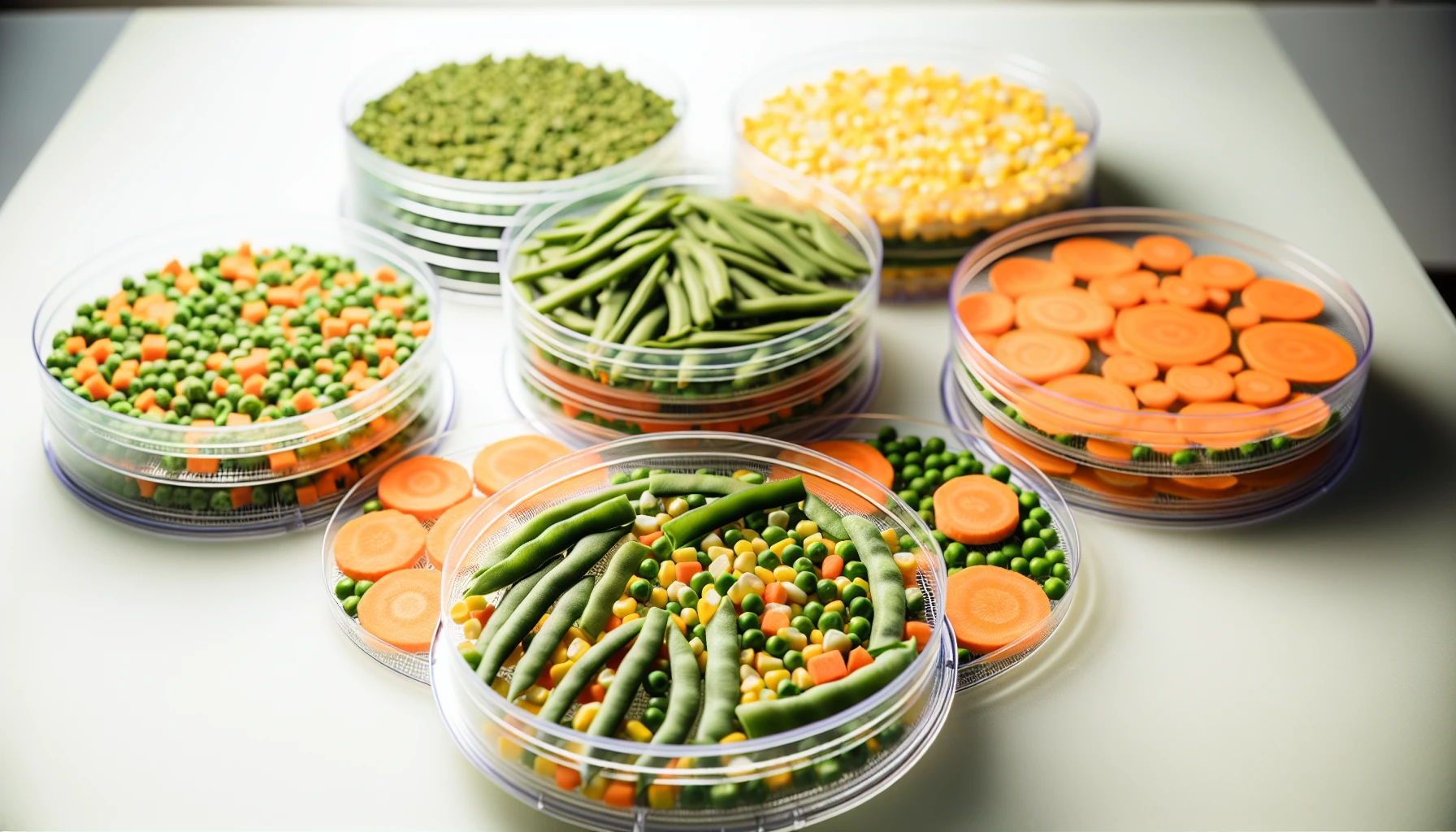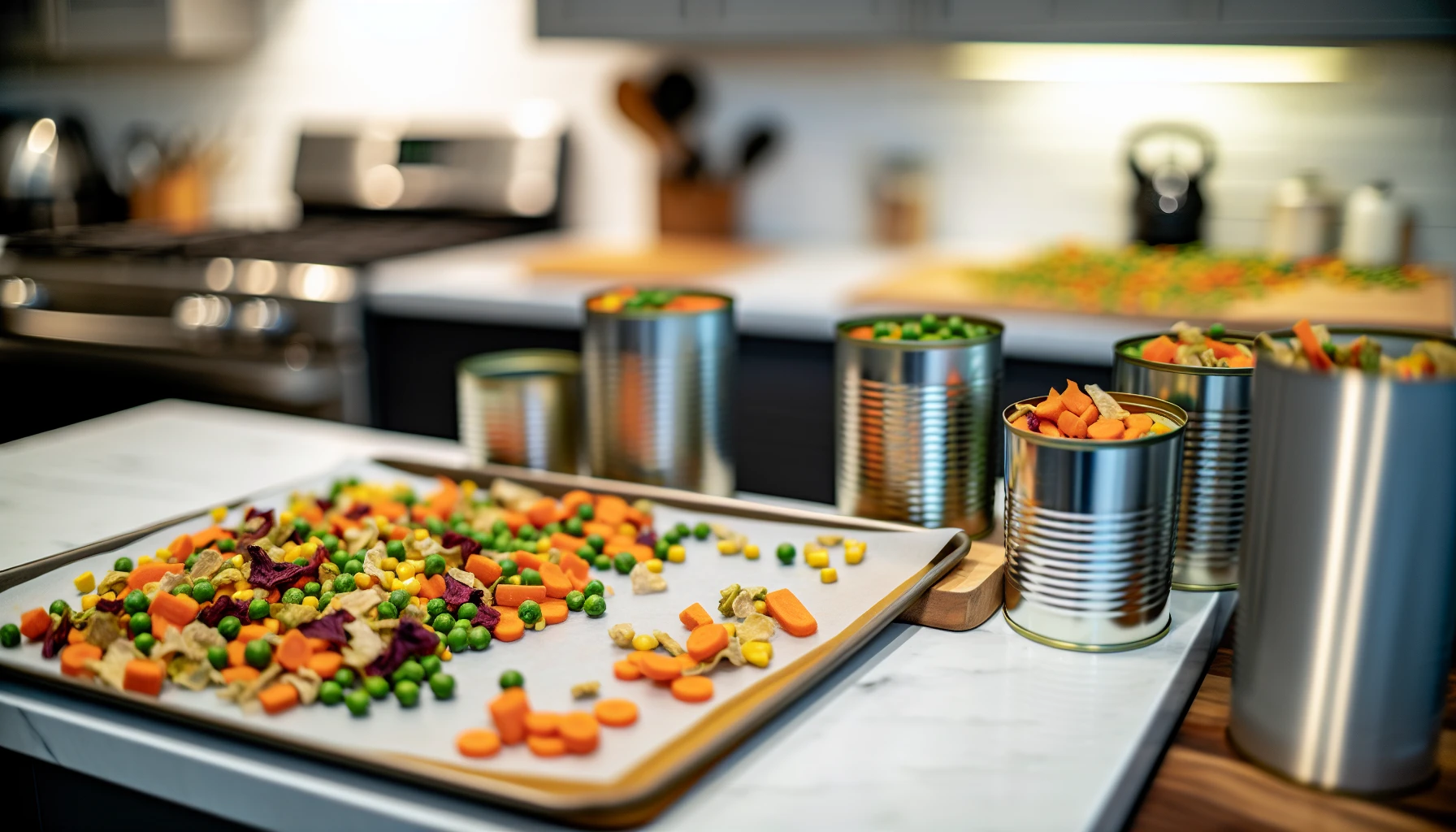Have you ever asked yourself, “can you dehydrate canned vegetables?” The idea might seem unconventional, but it’s an excellent way to preserve food and make it more portable. Dehydrating canned vegetables is a simple process that can help you create long-lasting and nutritious meals for various occasions. Let’s explore this unique technique and learn how it can benefit your food storage and meal planning.
Key Takeaways
- Canning and dehydrating vegetables is a popular preservation method with increased nutrition and convenience.
- Preparation for dehydrating canned vegetables involves rinsing, draining, and following instructions of the drying device used (dehydrator or oven).
- Proper storage of dried canned veggies includes airtight containers/vacuum sealing to ensure freshness up to 10 years.
Understanding Canned Vegetables and Dehydration
Canning vegetables, a popular preservation method, involves sealing food in an airtight container and subjecting it to heat to eliminate bacteria or microorganisms. This process can also make dehydrating canned vegetables easier, as the heat from canning can cause some of the water in the vegetables to evaporate. Dehydrating vegetables provides an increased level of nutrition and vibrancy to trail and emergency meals. Although fresh vegetables are the optimal choice for dehydration, frozen and canned vegetables can also be dehydrated, with canned vegetables being the simplest to dehydrate.
Dehydrating canned vegetables is a straightforward process, allowing you to create various dehydrated foods for long-term storage and use in different recipes. This post will examine:
- The science of canning vegetables
- Comparison of dehydration options for fresh, frozen, and canned vegetables
- Advice on dehydrating and storing canned vegetables at home.
The Science Behind Canning Vegetables
Canning vegetables entails enclosing them in airtight containers like cans or jars, then heating them to a high temperature to kill any present bacteria or microorganisms. Canning can be done either in a factory using machines or at home using water-bath canning or pressure canning methods. One of the advantages of canning vegetables, including canned beans, is that it saves time compared to cooking fresh vegetables and allows for effective rehydration in meals.
The canning process, if done correctly, does not reduce the nutritional value of the vegetables, making them suitable for creating dehydrated meals. For those mindful of their health, rinsing canned vegetables, such as mixed vegetables, before dehydrating is a good practice. This will reduce the sodium content in them significantly.
Comparing Fresh, Frozen, and Canned Vegetables for Dehydration
Fresh vegetables can be dehydrated in their raw state, while frozen and canned vegetables need to be precooked prior to dehydrating. When using dehydrated vegetables in recipes, you can add flavor by using ingredients like soy sauce. Dicing or slicing the vegetables and spreading them in a single layer on dehydrator trays is the process for dehydrating raw vegetables. To rehydrate them, you can use food soaks or add them directly to soups and stews.
Frozen vegetables can be used for drying. Examples include:
- Corn
- Peas
- Broccoli
- Green beans, which can be turned into dried green beans
- Okra
It is suggested to steam them for a period of six to eight minutes before dehydrating.
On the other hand, canned vegetables can be used to dehydrate vegetables by simmering them in a soup or stew.
Keep in mind that certain vegetables, like lima beans, should not be included in mixed vegetable dehydration.
How to Dehydrate Canned Vegetables at Home

You can dehydrate canned vegetables at home using either a food dehydrator or an oven. Proper preparation of the vegetables is key to successful dehydration in both cases.
The following sections will cover preparation of canned vegetables for dehydration and the dehydration process itself, using either a food dehydrator or an oven.
Preparing Canned Vegetables for Dehydration
Before dehydrating canned vegetables, it is recommended to follow these steps:
- Rinse the vegetables in fresh water for 15-20 minutes to remove any extra liquid or residue.
- Drain the canned vegetables by spreading them evenly on dryer trays and allowing them to drain and air dry for a few minutes to eliminate any remaining moisture.
- Once the vegetables are adequately prepared, you can initiate the dehydration process following the instructions for your respective dehydrator or oven.
Using a Food Dehydrator
Dehydrating canned vegetables using a food dehydrator is quite simple. Here’s how:
- Start by spreading the vegetables in a single layer on dehydrator trays covered with nonstick sheets or parchment paper.
- The recommended temperature for dehydrating most vegetables is 125°F (52°C).
- The exact drying time may vary depending on the type and thickness of the vegetables, but it generally takes between 4 to 6 hours for them to become dry and leathery.
Make sure to periodically turn the vegetable pieces and switch the positions of the trays during the dehydration process to achieve uniform drying. Once the vegetables are completely dehydrated, remove them from the dehydrator and allow them to cool before storing them in airtight containers or vacuum-sealed bags to maintain their freshness.
Using an Oven
If you don’t have a food dehydrator, you can still dehydrate canned vegetables using an oven. To do this, follow these steps:
- Preheat your oven to a low temperature, around 140-150°F (60-65°C).
- Drain the canned vegetables and spread them out in a single layer on a baking sheet or wire rack.
- Place the baking sheet or rack in the oven and leave the oven door slightly ajar to allow moisture to escape.
- Dry the vegetables in the oven for approximately 4 to 6 hours, or until they are brittle and fully dehydrated.
Monitor the progress of the vegetables periodically and turn them occasionally to ensure even drying. Once the vegetables are completely dehydrated, remove them from the oven and allow them to cool. Store the dehydrated vegetables in airtight containers or vacuum-sealed bags to maintain their freshness.
Creative Uses for Dehydrated Canned Vegetables

Dehydrated canned vegetables can be used in various ways, such as:
- Snacks
- Soups
- Stews
- Casseroles
- Backpacking meals
- Emergency meals
By incorporating dehydrated canned vegetables and canned fruits into your meals, you can add extra flavor and nutrition without adding significant weight or bulk.
The following sections will offer inventive ideas for using dehydrated canned vegetables in snacks, soups, stews, casseroles, and backpacking and emergency meals, as well as tips on how to rehydrate dehydrated food.
Snacks and Chips
Turning dehydrated canned vegetables into snacks or chips is a fun and healthy way to enjoy them. To create vegetable chips, follow these steps:
- Thinly slice the vegetables.
- Dehydrate them at a low temperature until they become crisp.
- Season your vegetable chips with various spices and flavors, such as sea salt, black pepper, garlic powder, onion powder, or herb blends.
Dehydrated vegetable snacks and chips are not only tasty but also provide a wealth of nutrients and can easily be packed for on-the-go snacking. These creative snacks are perfect for school lunches, road trips, or just munching on during a busy day.
Soups, Stews, and Casseroles

Incorporating dehydrated canned vegetables into your meals can enhance the flavor and nutritional value. Here are some examples of how you can use them:
- Add dehydrated spinach to pasta or rice dishes with tomato or cheddar cheese sauce
- Mix dehydrated vegetables with beans to create a flavorful soup
- Use dehydrated vegetables in stews and casseroles for added flavor and texture
The possibilities are limitless, and trying out diverse combinations of dehydrated canned vegetables can yield delicious and fulfilling meals, especially when paired with a flavorful tomato sauce.
Backpacking and Emergency Meals

Dehydrated canned vegetables are a great addition to backpacking and emergency meal planning. They are lightweight, easy to pack, and can provide essential nutrients when fresh or canned vegetables are not available. To use dehydrated canned vegetables in backpacking and emergency meals, simply rehydrate them by soaking them in water or adding them directly to your dishes.
With the right planning and storage, nutritious and flavorful meals for any outdoor trip or emergency scenario can be prepared.
Tips for Storing Dehydrated Canned Vegetables
Storing dehydrated canned vegetables properly is crucial for maintaining their freshness and nutritional value. The key to prolonging the life of dehydrated food is to prevent oxidation.
The following sections will cover the optimal practices for storing dehydrated canned vegetables for both short-term and long-term use, focusing on airtight containers and vacuum sealing.
Short-Term Storage
For short-term storage of dehydrated canned vegetables, consider airtight containers like zipper-closure plastic food storage bags or Ball Mason Jars. Store the vegetables in a cool, dark, and dry place, away from direct light and moisture.
When prepared and stored properly, dehydrated canned vegetables can stay good for up to 10 years in short-term storage.
Long-Term Storage
For long-term storage of dehydrated canned vegetables, it’s recommended to use vacuum sealing with an oxygen absorber. Vacuum sealing helps preserve the quality and flavor of the vegetables by avoiding exposure to air and moisture, extending their shelf life up to 10 years or more.
Vacuum sealing also safeguards the vegetables from pests and bacteria, ensuring their safety for consumption.
Summary
In conclusion, dehydrating canned vegetables is a versatile and practical method to preserve food and create delicious, nutrient-rich meals for various occasions. By understanding the canning process, comparing fresh, frozen, and canned vegetables for dehydration, and following the proper techniques for dehydrating and storing canned vegetables, you can expand your culinary horizons and ensure that you’re always prepared with nutritious options. So go ahead, give dehydrating canned vegetables a try, and enjoy the flavorful possibilities that await you.
Frequently Asked Questions
How long does dehydrated food last?
Dehydrated food can last for up to 15 years when properly prepared and stored in a cool, dry, dark environment. For shorter shelf lives, home dehydrated food typically lasts between 4-12 months, with fruit lasting up to 1 year and vegetables lasting about 6 months.
How to dehydrate?
Dehydrate foods by sun drying, air drying, solar drying, oven drying, electric dehydrators or microwave ovens. Check progress every 2 to 3 hours and rotate trays if necessary. Drying times can range from 6-36 hours depending on the food.
How to store dehydrated food?
For longer-term storage of properly dried food, store it in an airtight glass or hard plastic container with a seal, such as canning jars. Store in a cool, dark, dry place and use vacuum sealing for optimum preservation.
Can you dehydrate store-bought canned vegetables?
Yes, you can dehydrate store-bought canned vegetables using the same procedures as home-canned goods.
How long does it take to dehydrate canned vegetables?
It typically takes 4-6 hours for canned vegetables to dehydrate and become leathery.

